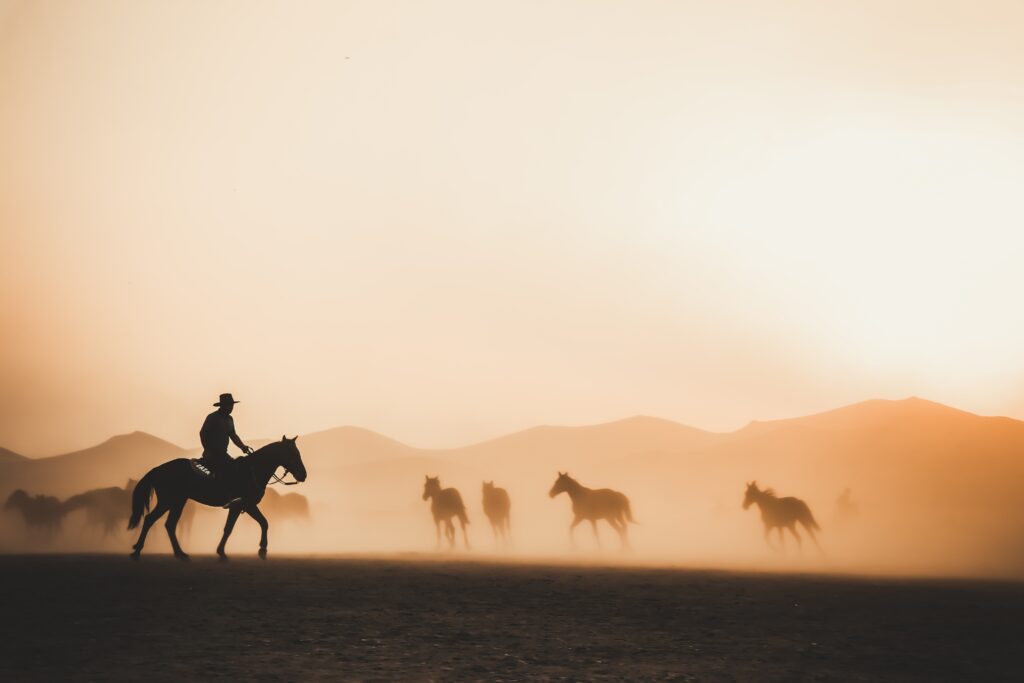Were there cowboys in Arizona? The answer is yes! In the vast tapestry of American history, Arizona’s cowboy legacy stands out as a testament to the rugged frontier spirit and the enduring legacy of the Old West. But were there cowboys in Arizona? Absolutely, and their history is a rich and complex tale that weaves together the Old West with the modern era, creating a unique cowboy culture that still thrives today.

The Early Days of Arizona Cowboys
Arizona’s Cowboy Origins:
The mid-19th century marked a pivotal moment in the history of Arizona, a territory that was then a wild and untamed land. It was a place where the vast, open spaces seemed to stretch endlessly, and where the frontier spirit was as untamed as the wilderness itself. Arizona was sparsely populated and largely unexplored, a land where untamed wilderness met the unquenchable human desire for expansion.
The Pioneer Movement:
The westward expansion movement of the 19th century was a defining characteristic of the United States during this era. Pioneers and settlers embarked on arduous journeys. Often by covered wagon, seeking new opportunities and a chance at a better life in the West. These pioneers ventured into territories like Arizona, lured by the promise of fertile land and abundant resources.
Cattle Ranching Emerges:
Among the many things pioneers brought with them on their treks west were cattle. Cattle ranching emerged as a vital industry, not only in Arizona but throughout the American West. It was driven by the increasing demand for beef as well as the lure of open range where cattle could graze freely and abundantly.
The Need for Cowboys:
As herds of cattle grew, so did the need for skilled individuals to manage them. Cowboys, or cattle herders, became a necessity. These men, often young and adventurous, were tasked with guiding cattle across the open prairies, ensuring their safety, and driving them to market. This marked the birth of what would become the iconic cowboy lifestyle.
Challenges and Adventures:
Life as a cowboy in 19th century Arizona was a far cry from the romanticized image often depicted in movies. It was a rugged existence, filled with long, grueling days in the saddle under the scorching sun. Cowboys faced numerous challenges, from cattle rustlers and harsh weather to encounters with Native American tribes and outlaws.
The Cowboy’s Code:
Despite these hardships, a distinct cowboy culture emerged, rooted in a code of honor and ethics. Cowboys prided themselves on their grit, resilience, and unwavering work ethic. The code of the West emphasized values such as loyalty, integrity, and courage. This code became an intrinsic part of the cowboy way of life.
Legacy of the Pioneering Spirit:
The pioneer movement and the emergence of cattle ranching in Arizona not only defined the cowboy culture but also left a lasting legacy on the state’s history and identity. Today, Arizona’s history is intricately entwined with the stories of those early pioneers and the cowboys who helped shape the land.
In essence, the mid-19th century in Arizona was a time of incredible transformation. It was a period when the untamed wilderness met the indomitable human spirit, and the need for cowboys to manage herds of cattle was just one chapter in the larger story of the American West. The pioneers who ventured into Arizona and the cowboys who followed in their wake left a profound mark on the state’s history, culture, and identity. Their stories continue to echo through time, reminding us of the enduring spirit of the Wild West.
Cattle Ranching in the Arid West:
The heart of cowboy culture in Arizona was, and still is, cattle ranching. The vast open spaces, favorable climate, and ample grazing land made the territory ideal for raising cattle. Cowboys herded, branded, and protected cattle from rustlers and predators, and they worked tirelessly under the relentless Arizona sun.
Vaqueros and Buckaroos:
The influence of Mexican vaqueros and Californian buckaroos on Arizona’s cowboy culture cannot be overstated. The vaquero tradition, characterized by roping and riding skills, contributed significantly to the techniques employed by Arizona’s cowboys. Buckaroos, who developed a distinctive style of clothing and horsemanship in California. Also left their mark on the cowboy culture of Arizona.

The Wild West and Arizona Cowboys
Gunfights and Outlaws:
The Wild West, as depicted in countless movies and books, was not without its fair share of outlaws and violent confrontations. Arizona bore witness to several notorious figures. The Clanton Gang, the Earp Brothers, and the “Gunfight at the O.K. Corral” in Tombstone remain emblematic of the rugged, lawless nature of the times.
Cowboys in the Mines:
Besides their work on cattle ranches, cowboys found employment in Arizona’s burgeoning mining industry. They herded and transported goods, guarded valuable shipments, and sometimes even served as lawmen in the rough-and-tumble mining towns that dotted the landscape.
The Birth of Rodeo:
The modern rodeo, born out of the ranching traditions of the West, is an integral part of Arizona’s cowboy culture. Arizona is no stranger to rodeo events. The annual Prescott Frontier Days Rodeo is a prime example of the thrilling spectacle that brings together modern-day cowboys and spectators alike.

Arizona Cowboys Today
Working Ranches:
While the Wild West has given way to more urban and suburban development, many working ranches in Arizona still employ cowboys. These modern-day cowboys continue to manage cattle and maintain the traditions passed down through generations.
Rodeo Circuits and Competitions:
Arizona is home to a thriving professional rodeo circuit. Modern cowboys showcase their skills in events such as bull riding, calf roping, steer wrestling, and barrel racing. Rodeo competitions draw participants and enthusiastic spectators alike, keeping the cowboy tradition alive and vibrant.
The Enduring Cowboy Spirit:
The cowboy spirit is deeply ingrained in Arizona’s cultural identity. It can be seen in the state’s annual cowboy-themed events, from the Parada del Sol Rodeo in Scottsdale to the Tucson Rodeo and the Arizona Black Rodeo. Western wear shops, cowboy festivals, and dedicated museums also attest to Arizona’s commitment to preserving cowboy traditions.
In conclusion, when asking the question, “Were there cowboys in Arizona?” the resounding answer is a definitive “yes.” Arizona’s cowboy legacy is more than a chapter in the state’s history. It’s a living, breathing testament to the enduring spirit of the Wild West. From its origins in cattle ranching to the thrilling rodeos of today.
The cowboy culture remains an integral part of Arizona’s identity. Whether you’re exploring the state’s historic landmarks, visiting working ranches, or watching a modern rodeo, you’ll find the cowboy spirit alive and well in the heart of Arizona. So, saddle up and journey through time.
Check out our other posts like “Route 66 in Arizona“











